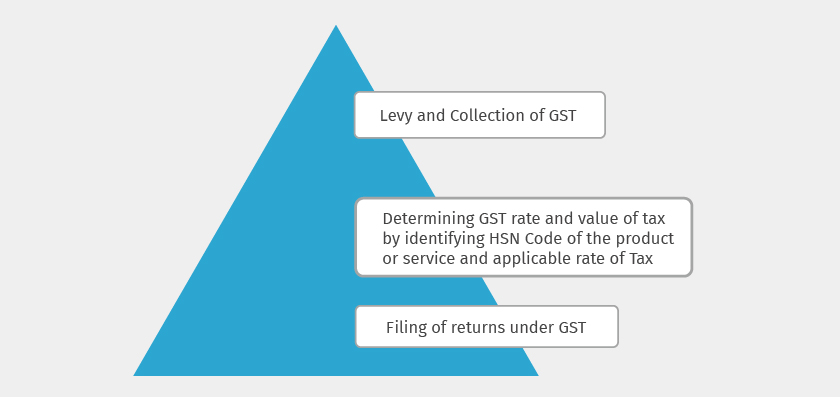What is HSN code under GST?
HSN stands for Harmonized System of Nomenclature which was developed by the World Customs Organization (WCO) with the vision of classifying goods all over the World in a systematic manner.
WCO has 181 members, three-quarters of which are developing countries that are responsible for managing more than 98 percent of world trade. HSN standardizes the classification of merchandise under sections, chapters, headings, and subheadings. This results in a six-digit code for a commodity (two digits each representing the chapter, heading, and subheading).
India, a member of WCO since 1971, has been using HSN codes since 1986 to classify commodities for Customs and Central Excise. Customs and Central Excise added two more digits to make the codes more precise, resulting in an eight-digit classification.
Importance of HSN codes in GST
HSN codes are essential for seamless GST compliance, serving as a standardized classification system for goods. Accurate HSN code reporting streamlines tax processes by categorizing goods, facilitating efficient tax calculation and documentation. Thus utilizing HSN codes offers numerous benefits for businesses. They enable accurate determination of applicable GST rates, simplifying GST return filing and reducing error risks. Standardized coding enhances transparency in tax administration, fostering a conducive business environment. Employing HSN codes also streamlines inventory management and supply chain operations, enhancing overall efficiency. Adherence to HSN code requirements showcases commitment to regulatory compliance, fostering trust among stakeholders.
The usage of HSN code for GST
- The HSN code under GST of six digit forming an uniform code helps in classifying over 5,000 products and is accepted worldwide
- The GST HSN helps in taxation purposes in identifying the HSN code wise GST rate applicable to a product in a country
- The HSN code under GSTis also used to determine the quantum of item traded or imported all through a nation
HSN Code List for GST India
HSN has been applicable in India after implementation of GST. India has already been using HSN system in the Central Excise and Customs regime.
But the GST HSN is a much more detailed classification that adds another two digits to the 6-digit structure. For certain categories of person in GST, there is even an requirement to mention HSN code with GST rate in the tax invoices prepared by them.
HSN codes to be declared
Under GST law, the HSN code to be used by a taxpayer for classification of goods will be based on the taxpayer's turnover. The HSN code needs to be declared on the tax invoice and also to be reported while filing the GST returns.
The HSN codes for mandatory mapping/classification of goods that need to be used by a taxpayer are as follows;
- Taxpayers whose turnover is Rs. 5 crore and above shall use 4 digit HSN code
- Taxpayers whose turnover is above Rs. 1.5 crore but below Rs. 5 crore shall use 2 digit HSN code
- Taxpayers whose turnover is below Rs. 1.5 crore are not required to mention HSN code in their invoices
- The draft list of HSN codes released and available in the public domain can be assessed on the government GST website
- Under the GST laws, the services will be classified as per the Services Accounting Code(s) (SAC)
Provisions related to HSN code for GST India
- Small taxpayers with annual turnover up to Rs 1.50 crores in preceding financial year need not be required to mention HSN code wise GST rate in their tax invoice
- Taxpayers having turnover exceeding Rs. 1.5 crore but up to 5.00 crore will be required to mention only two digits of GST HSN
- All those taxpayers having turnover exceeding Rs 5 Crore will be required to mention four digits of GST HSN
HSN code list for outward supplies
| Sections | HSN code list |
| Section 1 | Live Animals, Animal Products |
| Section 2 | Vegetable Products |
| Section 3 | Animal or Vegetable Fats and Oils and their cleavage products, prepared edible fats, Animal or Vegetable waxes |
| Section 4 | Prepared Foodstuffs, Beverages, Spirits and Vinegar, Tobacco and Manufactured Tobacco Substitutes |
| Section 5 | Mineral Products |
| Section 6 | Product of the chemicals or allied Industries |
| Section 7 | Plastics and articles thereof, Rubber and articles thereof |
| Section 8 | Raw hides and skins, Leather, Furskins and articles thereof, saddlery and harness, travel goods, handbags and similar containers, articles of animal gut ( other than silk-worm gut ) |
| Section 9 | Wood and articles of wood, Wood charcoal, Cork and articles of cork, Manufacturers of straw, of Esparto or of other Plaiting Materials, Basketwork and Wickerwork |
| Section 10 | Pulp of wood or of other Fibrous Cellulosic Material, Recovered ( Waste and scrap ) paper or paperboard, paper and paperboard and articles thereof |
| Section 11 | Textile and textile articles |
| Section 12 | Footwear, Headgear, Umbrellas, Sun Umbrellas, Walking-sticks, seat-sticks, whips, riding-crops and parts thereof, Prepared feathers and articles made therewith, Artificial flowers, Articles of human hair |
| Section 13 | Articles of stone, plaster, cement, asbestos, mica, or similar materials, ceramic products, glass and glassware |
| Section 14 | Natural or cultured pearls, Precious or semi-precious stones, precious metals, Metal clad with precious metal, and articles thereof, Imitation Jewellery, Coins |
| Section 15 | Base Metals and articles of Base Metal |
| Section 16 | Machinery and mechanical appliances, electrical equipment, parts thereof, sound recorders and reproducers, television image and souch recorders and reproducers, and Parts and Accessories of such article |
| Section 17 | Vehicles, Aircraft, Vessels and Associated Transport Equipment |
| Section 18 | Optical, Photographic, Cinematographic, measuring, checking, precision, medical or surgical instruments and apparatus, clocks and watches, musical instruments, parts and accessories thereof |
| Section 19 | Arms and ammunition, parts and accessories thereof |
| Section 20 | Miscellaneous Manufactured Articles |
| Section 21 | Works of art, Collectors’ Pieces and antiques |
Structure of GST HSN code
The coding process of a commodity is organized logically by economic activity or component material. For example, animals and animal products are found in one section of the HS, while machinery and mechanical appliances are found in another. The HSN book for referring to an HSN Code for a product is organized into following, by which one can make a quick reference to the HSN Code for the product he is searching for:
|
Sections and Chapter titles |
Describes about broad categories of goods The first two digits of HSN Code is designated to HSN Chapter These are arranged in order of a product’s degree of manufacture or in terms of its technological complexity. For Example : within Section X (Pulp of wood or of other fibrous cellulosic material; Recovered (waste and scrap) paper or paperboard; Paper and paperboard and articles thereof), Chapter 47 provides for pulp of wood or of other fibrous cellulosic materials, whereas Chapter 49 covers printed books, newspapers, and other printed matter For instance, natural commodities, such as live animals and vegetables are described in the early sections of the HS, whereas more evolved goods such as machinery and precision instruments are described in later sections |
|
Headings and Sub-headings |
Describes the product specifically or in detail The next two digits of HSN Code is attributed to Headings and the third set of two digits is for HS Sub Headings The headings within individual Chapters follow a similar order. For example, the first heading in Chapter 50 (Silk) provides for silkworm cocoons while articles made of silk are covered by the chapter's later headings |
GST HSN code search
- How do I carry out a GST HSN Code Search?
- You will need a GST rate finder tool to find the HSN code for the given product
- There are other ways also to decode HSN code for a given product such as by visiting Central Board or excise and customs department website and other third party apps on play store and iOS platform
- Why do I need a GST rate finder?
- Indian Taxation System has categorized over 1211 goods for levy of GST under 6 broad categories or tax-slabs
- These are 0% or No Tax, 5%, 12%, 18% and 28%
So it becomes important to know in which of these categories your product or good has been classified. And one can easily find that with a search using commonly used word for the product.
So the Rate Finder Tool is used to find the HSN Code for the goods or products for invoicing purposes.
Relationship of HSN code and GST rate

Consequences of incorrect HSN codes usage
Incorrect usage of HSN codes can have significant consequences for businesses, ranging from financial penalties to operational disruptions. Non-compliance with GST regulations due to inaccurate HSN code reporting may result in fines and legal implications, undermining the financial stability and reputation of the business.
Moreover, incorrect HSN codes can lead to misclassification of goods, resulting in erroneous tax calculations and potential disputes with tax authorities. This can lead to delays in tax refunds and additional administrative burdens on businesses.
Furthermore, inaccurate HSN codes may impact business operations, causing delays in customs clearance, supply chain disruptions, and customer dissatisfaction due to incorrect invoicing or pricing.
To mitigate these risks, businesses must prioritize the accurate assignment and reporting of HSN codes, investing in training, resources, and technology to ensure compliance with GST regulations. By doing so, businesses can safeguard their financial interests and maintain regulatory integrity in their operations.
FAQs on HSN code list under GST
How does HSN code work?
HSN is a six-digit code that classifies more than 5000 products, arranged in a legal and logical structure. To achieve uniform classification, the HSN is supported by well-defined rules and is accepted worldwide.
HSN classification is widely used for taxation purposes by helping to identify the rate of tax applicable to a specific product in a country that is under review. It can also be used in calculations that involve claiming benefits.
Yet that’s not all – it also applies to import and exports. The HSN code aids in determining the quantity of all items imported or traded through a nation.
Why is HSN important under GST?
While the primary purpose of the HSN code is the systematic classification of goods, it can also be used to gather data and solve problems that would otherwise be difficult to obtain. The result is a more efficient international trade system.
HSN is in use worldwide, with 200+ countries participating. This impressive adoption rate can be chalked up to the benefits of HSN, which include:
- Collection of international trade statistics
- Provision of a rational basis for Customs tariffs
- Uniform classification
Nearly 98% of international trade stock is classified in terms of HSN, further evidence of its reputation as the best form of international classification.
HSN numbers exist for each commodity in every country, and the number remains the same for almost all goods. In some countries, HSN numbers can vary a little because they are entirely based on the nature of the items classified.
Is HSN Code is required while GST return filing?
Watch Video on Validate HSN or SAC Information Using TallyPrime
Watch Video on How to Update HSN Code for Stock Items in TallyPrime
Read More on GST Rates & Charges
GST Rates, GST Rate Finder, GST Rate on Labour Charges, SAC Codes, GST State Codes
GST
GST Software, GST Calculator, GST on Freight, GST on Ecommerce, GST Impact on TCS, GST Impact on TDS, GST Exempted Goods & Services, Reverse Charge Mechanism in GST, GST Declaration
Types of GST
CGST, SGST, IGST, UTGST, Difference between CGST, SGST & IGST
GST Returns
GST Returns, Types of GST Returns, New GST Returns & Forms, Sahaj GST Returns, Sugam GST Returns, GSTR 1, GSTR 2, GSTR 3B, GSTR 4, GSTR 5, GSTR 5A, GSTR 6, GSTR 7, GSTR 8, GSTR 9, GSTR 10, GSTR 11
















